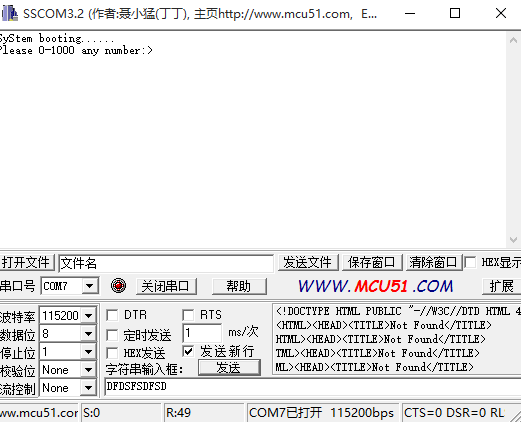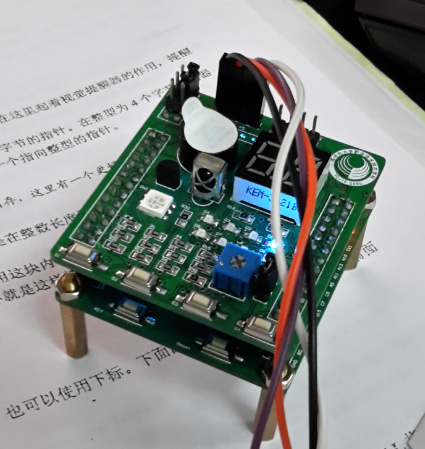第7次作业:
温度变化控制RGB的颜色变化
高温报警功能
#include "stm32f10x.h"
#include "stm32_eval.h"
#include <stdio.h>
#define VREF 3.3
#define Set_B20() GPIO_SetBits(GPIOC, GPIO_Pin_12)
#define Reset_B20() GPIO_ResetBits(GPIOC, GPIO_Pin_12)
#define Read_B20() GPIO_ReadInputDataBit(GPIOC,GPIO_Pin_12)
volatile int flag;
unsigned char Error_Flag=0;
unsigned char zf=0;
float num=0;
unsigned int temp=1024;
GPIO_InitTypeDef GPIO_InitStructure;
USART_InitTypeDef USART_InitStructure;
TIM_OCInitTypeDef TIM_OCInitStructure;
TIM_TimeBaseInitTypeDef TIM_TimeBaseStructure;
USART_ClockInitTypeDef USART_ClockInitStructure;
void delay_us(u32 n)
{
u8 j;
while(n--)
for(j=0;j<10;j++);
}
void delay_ms(u32 n)
{
while(n--)
delay_us(1000);
}
void RCC_Configuration(void)
{
SystemInit();
}
void GPIO_int(){
RCC_APB2PeriphClockCmd(RCC_APB2Periph_GPIOD, ENABLE);
GPIO_InitStructure.GPIO_Pin = GPIO_Pin_2;
GPIO_InitStructure.GPIO_Speed = GPIO_Speed_50MHz;
GPIO_InitStructure.GPIO_Mode = GPIO_Mode_Out_PP;
GPIO_Init(GPIOD, &GPIO_InitStructure);
}
void USART_int(long BaudRate)
{
RCC_APB2PeriphClockCmd(RCC_APB2Periph_GPIOA|RCC_APB2Periph_USART1,ENABLE);
GPIO_InitStructure.GPIO_Pin = GPIO_Pin_9;
GPIO_InitStructure.GPIO_Speed = GPIO_Speed_50MHz;
GPIO_InitStructure.GPIO_Mode = GPIO_Mode_AF_PP;
GPIO_Init(GPIOA, &GPIO_InitStructure);
GPIO_InitStructure.GPIO_Pin = GPIO_Pin_10;
GPIO_InitStructure.GPIO_Mode = GPIO_Mode_IN_FLOATING;
GPIO_Init(GPIOA, &GPIO_InitStructure);
USART_InitStructure.USART_BaudRate = BaudRate;
USART_InitStructure.USART_WordLength = USART_WordLength_8b;
USART_InitStructure.USART_StopBits = USART_StopBits_1;
USART_InitStructure.USART_Parity = USART_Parity_No;
USART_InitStructure.USART_HardwareFlowControl = USART_HardwareFlowControl_None;
USART_InitStructure.USART_Mode = USART_Mode_Rx | USART_Mode_Tx;
USART_ClockInitStructure.USART_Clock = USART_Clock_Disable;
USART_ClockInitStructure.USART_CPOL = USART_CPOL_Low;
USART_ClockInitStructure.USART_CPHA = USART_CPHA_2Edge;
USART_ClockInitStructure.USART_LastBit = USART_LastBit_Disable;
USART_ClockInit(USART1, &USART_ClockInitStructure);
USART_Init(USART1, &USART_InitStructure);
USART_Cmd(USART1, ENABLE);
USART_ITConfig(USART1, USART_IT_RXNE, ENABLE);
USART_Cmd(USART1, ENABLE);
}
void PWM_Config()
{
uint16_t PrescalerValue = 0;
/* TIM2 clock enable */
RCC_APB1PeriphClockCmd(RCC_APB1Periph_TIM2, ENABLE);
/* GPIOA enable */
RCC_APB2PeriphClockCmd(RCC_APB2Periph_AFIO,ENABLE);
GPIO_InitStructure.GPIO_Pin = GPIO_Pin_1|GPIO_Pin_2|GPIO_Pin_3;
GPIO_InitStructure.GPIO_Mode = GPIO_Mode_AF_PP;
GPIO_InitStructure.GPIO_Speed = GPIO_Speed_50MHz;
GPIO_Init(GPIOA, &GPIO_InitStructure);
TIM_Cmd(TIM2, ENABLE);
PrescalerValue = (uint16_t) (SystemCoreClock / 24000000) - 1;
TIM_TimeBaseStructure.TIM_Period = 0x07FF;
TIM_TimeBaseStructure.TIM_Prescaler = PrescalerValue;
TIM_TimeBaseStructure.TIM_ClockDivision = 0;
TIM_TimeBaseStructure.TIM_CounterMode = TIM_CounterMode_Up;
TIM_TimeBaseInit(TIM2, &TIM_TimeBaseStructure);
TIM_OCInitStructure.TIM_OCMode = TIM_OCMode_PWM1;
TIM_OCInitStructure.TIM_OCPolarity = TIM_OCPolarity_High;
TIM_OCInitStructure.TIM_OutputState = TIM_OutputState_Enable;
TIM_OCInitStructure.TIM_Pulse = 0xFFFF;
TIM_OC2Init(TIM2, &TIM_OCInitStructure);
TIM_OCInitStructure.TIM_OutputState = TIM_OutputState_Enable;
TIM_OCInitStructure.TIM_Pulse = 0xFFFF;
TIM_OC3Init(TIM2, &TIM_OCInitStructure);
TIM_OCInitStructure.TIM_OutputState = TIM_OutputState_Enable;
TIM_OCInitStructure.TIM_Pulse = 0xFFFF;
TIM_OC4Init(TIM2, &TIM_OCInitStructure);
TIM_ARRPreloadConfig(TIM2, ENABLE);
}
void delay_18b20(u32 nus)
{
u16 i;
while(nus--)
for(i=12;i>0;i--);
}
void Init18B20(void)
{
u8 aa=0;
u8 count =0;
RCC_APB2PeriphClockCmd(RCC_APB2Periph_GPIOC, ENABLE);
GPIO_InitStructure.GPIO_Pin = GPIO_Pin_12;
GPIO_InitStructure.GPIO_Mode = GPIO_Mode_Out_OD;
GPIO_Init(GPIOC, &GPIO_InitStructure);
Set_B20() ;
delay_18b20(1);
Reset_B20();
delay_18b20(480);
Set_B20();
delay_18b20(480);
count=0;
aa=Read_B20();
while(!aa && count<100)
{
aa=Read_B20();
count++;
}
if(count>=99)
Error_Flag=1;
else
Error_Flag=0;
}
unsigned char Read18B20(void)
{
unsigned char i=0;
unsigned char date=0;
u8 tempp;
for(i=8;i>0;i--)
{
Reset_B20();
date>>=1;
delay_18b20(1);
Set_B20();
delay_18b20(1);
tempp=Read_B20();
if(tempp)
date|=0x80;
delay_18b20(60);
}
return(date);
}
void Write18B20(unsigned char date)
{
unsigned char i=0;
for (i=8; i>0; i--)
{
Reset_B20();
delay_18b20(1);
if(date & 0x01)
{
Set_B20();
}
else
{ Reset_B20();}
delay_18b20(60);
date>>=1;
Set_B20();
delay_18b20(1);
}
delay_18b20(15);
}
float Read_T()
{
unsigned char TUp,TDown;
unsigned char fTemp;
u8 TT=0;
float Temp = 0;
Init18B20();
Write18B20(0xcc);
Write18B20(0x44);
Init18B20();
Write18B20(0xcc);
Write18B20(0xbe);
TDown = Read18B20();
TUp = Read18B20();
if(TUp>0x7f)
{
TDown=~TDown;
TUp=~TUp+1;
TUp/=8;
zf=1;
}
else
zf=0;
fTemp=TDown&0x0f;
TUp<<=4;
TDown>>=4;
TT=TUp|TDown;
Temp=TT+(float)fTemp/16;
return(Temp);
}
int main(void)
{
RCC_Configuration();
GPIO_int();
USART_int(115200);
printf(" config done...\r\n");
PWM_Config();
delay_ms(1000);
while(1)
{
num=Read_T();
printf("The Temperature is:%f\r\n",Read_T());
if(num>1&num<=18){
TIM_SetCompare2(TIM2, temp);
TIM_SetCompare3(TIM2, temp);
TIM_SetCompare4(TIM2, temp);
delay_ms(1000);
TIM_SetCompare2(TIM2,2048);
TIM_SetCompare3(TIM2,2048);
TIM_SetCompare4(TIM2,2048);
delay_ms(1000);
}else if(num>18&num<=20){
TIM_SetCompare2(TIM2, temp);
delay_ms(1000);
TIM_SetCompare2(TIM2,2048);
delay_ms(1000);
}else if(num>20&num<=25){
TIM_SetCompare4(TIM2, temp);
delay_ms(1000);
TIM_SetCompare4(TIM2,2048);
delay_ms(1000);
}else if(num>25){
TIM_SetCompare3(TIM2, temp);
GPIO_SetBits(GPIOD,GPIO_Pin_2);
delay_ms(1000);
TIM_SetCompare3(TIM2,2048);
GPIO_ResetBits(GPIOD,GPIO_Pin_2);
delay_ms(1000);
}
}
}
#ifdef USE_FULL_ASSERT
void assert_failed(uint8_t* file, uint32_t line)
{
while (1){}
}
#endif
#ifdef __GNUC__
#define PUTCHAR_PROTOTYPE int __io_putchar(int ch)
#else
#define PUTCHAR_PROTOTYPE int fputc(int ch, FILE *f)
#endif
PUTCHAR_PROTOTYPE
{
USART_SendData(EVAL_COM1, (uint8_t) ch);
while (USART_GetFlagStatus(EVAL_COM1, USART_FLAG_TC) == RESET)
{}
return ch;
}
#ifdef USE_FULL_ASSERT
void assert_failed(uint8_t* file, uint32_t line)
{
while (1){}
}
#endif



 我要赚赏金
我要赚赏金

